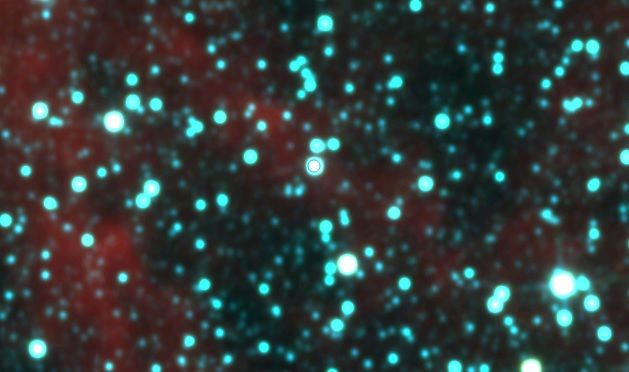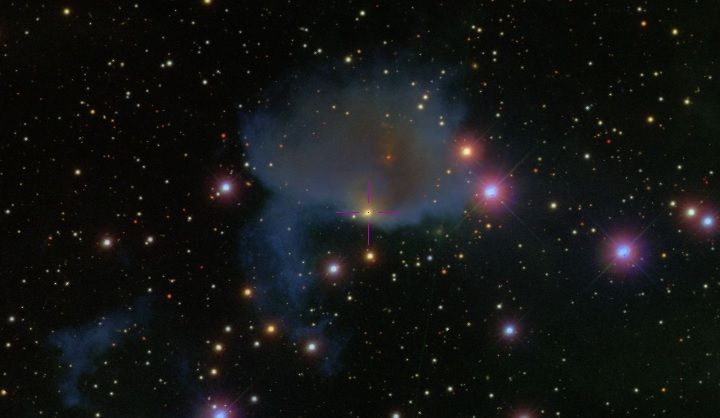extended beyond the circle
-
 by
marca
by
marca
AWI00043cx.
I thought that "extended" meant the white and light blue parts of the object, so I'm confused now by the comment of voyager. So if there is "many" dark blue around the red circle, it is also "extended"?Posted
-
 by
TED91
moderator
by
TED91
moderator
You thought right. I agree with @voyager1682002, this is "extended" , it's beyond red circle.
Posted
-
 by
marca
by
marca
I'm very sorry, but I'm still confused. Can someone tell me why it is extended? What I am missing?
Posted
-
 by
voyager1682002
moderator
by
voyager1682002
moderator
Take a look at Marc's comment on a similar image : http://talk.diskdetective.org/#/subjects/AWI0001zjc
If you look carefully, the light blue part of the object looks a bit extended outside the red circle.
Like this image: http://talk.diskdetective.org/#/subjects/AWI0002dw9, the white and light blue is inside the circle. That's only my observation and how I classify images. I hope it helps 😃
Posted
-
 by
marca
by
marca
Thanks. I think I understand my "problem" now. There are in fact four colours:white, light blue, middle-blue and dark blue, and the middle blue is also part of the object. It's sometimes hard to see, but I think I have more grip on it now.
Posted
-
Please confirm whether these objects extend beyond the circle in WISE 4 and if they should therefore be excluded:
http://talk.diskdetective.org/#/subjects/AWI0005qux
http://talk.diskdetective.org/#/subjects/AWI0004d4o
Thank you kindly!
Posted
-
 by
anoxie
by
anoxie
I'm still confused about the difference between extended and blended.
Let's take marca's example AWI00043cx:
-It is extended beyond red circle.
-There are no multiple objects in the red circle but faint multiple objects just beyond the circle.
-These objects seem to show up in WISE 4 and seem to be responsible for the extension.
Btw contrast of faint sources show up differently (compare right and left bottom corners of this example) in ALLWISE and WISE 1-4 here.
And the question 😃 :
What's the point of tagging an image "extended beyond the circle" if there is no multiple objects in the circle or beyond?
Posted
-
 by
TED91
moderator
in response to anoxie's comment.
by
TED91
moderator
in response to anoxie's comment.
What's Blended object is explained in this DD Glossary.
Object is extended if that "white" and/or "light blue" part is beyond the red circle. (which AWI00043cx is)
This can mean that the object is either blended, or there is somewhere "close" source of contamination. As you pointed out correctly, this source of the extension can be also outside the red circle.

Even interstellar dust like in these WISE images can be responsible for this.
That's why we should describe these objects as "extended beyond circle in WISE images"
Posted
-
 by
anoxie
by
anoxie
Sorry, but i'm still confused, in the glossary:
"Blended object. This refers to any object observed in an image that is actually comprised of two or more distinct astronomical sources. This can occur for images that have low spatial resolution"
WISE 4 images have low spatial resolution. AWI00043cx is blended at WISE 4. My interpretation is "extended" means "blended at WISE 4" for this example, and in most cases.
Posted
-
 by
TED91
moderator
by
TED91
moderator
Well, you're actually kind of right,but...
Blended object means, that right behind the star there is a background galaxy for example, but the source of the extension can be even several arcseconds away, or interstellar dust can be responsible for this. I think that this is a basic difference. I'll try to find some examples tomorrow and explain it on them. It's already too late here.
Posted
-
 by
anoxie
by
anoxie
TED, you wrote about this object (AWI00016lg) at WISE 1 : "blend", i agree, and you've pointed to the images, the other object is not "right behind".
Resolution at WISE 4 is lower, and what is "extended" is often a "blend" but the overlap is not perfect and your example rightly points to interstellar dust, thank you, i think we agree.
Posted
-
 by
anoxie
by
anoxie
More thought about interstellar dust:
TED, I'm wondering if we can actually see dust on disc detective and whether it may be responsible for an "extended" image. I've been looking for such an example as you have suggested and so far this is the kind of image i find:
Stars behind interstellar dust on disc detective vs AllWISE: AWI00016vs
Image is smoothed and contrast enhanced such as faint multiple sources and interstellar dust don't show up in disc detective.
Posted
-
 by
anoxie
by
anoxie
This leads to another question:
I've just read the Disk Detective blog, may 30, 2014 :
Also, as we look closer to the Galactic plane, the kinds of
contamination will change. The plane of the Milky Way is chock full
of interstellar dust clouds, as the image on the right shows. Beware,
some of those clouds may have patterns in them that mimic the
appearance of our disk candidates!So here ( AWI00016vs ) we have an example that interstellar dust is responsible for contamination, not for an "extended" image. Has this kind of contamination been taken into acount when calculating the excess in the IR?
Should we tag all these sources with #contamination or #interstellar-dust?
Posted
-
 by
TED91
moderator
in response to anoxie's comment.
by
TED91
moderator
in response to anoxie's comment.
That depends. For example, you can see some reflection nebulae in DSS and SDSS images, but you'll see interstellar dust mainly in WISE images.
Good example of dust cloud is dust around AWI0005wky, you can see dust all over the place.

Interstellar dust can be responsible for extension, I'm sure that you'll be able to find one or two examples here, You can tag those objects as #contaminated or #extended.
Unfortunately, we're not able to see disks around stars in the Disk Detective images. Here's Why
Posted
-
 by
anoxie
by
anoxie
I don't know if it's a good example because this cloud can be seen in DSS images.
But it may illutrate my point:
Whereas the veil is obvious in AllWISE images, you've to extrapolate its presence on the basis of a faint subjective extension in disk detective WISE 4 image (and the second object on the left has disappeared of WISE images!)
Posted
-
 by
anoxie
by
anoxie
I've just had a second look to a collection of stars with an unusual SED, it turned out most of these stars are behind an optically thick interstellar-dust cloud.
This kind of contamination may be suggested by the unusual pattern of the SED and excess in the IR and is obvious with a wider field on AllWISE / DSS images in Aladin.
These stars are in the dark regions (optically thick interstellar-dust) of the galactic plane:

And i'm definitely not convinced the "extension" of the image is a good criterium to sort out these stars.
Posted
-
 by
marckuchner
scientist, admin
by
marckuchner
scientist, admin
Hi anoxie. I'm just catching up here. But maybe I can help. Our Galaxy is full of interstellar dust that is not part of the dust disks we're searching for. We often see objects on Disk Detective that consist of an otherwise dust-free star that just happens to be in front of an ugly, unrelated blob of interstellar dust. That's the main reason we have the "extended" button, because the interstellar dust blob often looks bigger than the red circle--usually at WISE 3 of WISE 4. Thanks for all the questions! Best, Marc
Posted
-
 by
anoxie
by
anoxie
Hi, i may be biased since i only look at the SED of stars which look like potential good candidates, so most of extended images i discard routinely may have interstellar dust.
But i've seen such stars to classify : AWI0005hmu , AWI00016wo
Then the question is how do you deal with the "interstellar reddening" to calculate the IR excess?
I've tried to be a little more systematic tonight, and in the last row of 100 stars i've classified, besides obvious extended and distorted candidate at WISE 3 - 4 i've found a significant proportion of stars which seemed maybe reddened by interstellar dust and quite round at WISE 3-4 (2y2c, 186w, 3g70, 3068, 1q62, 53k5, 5d06...)
Thanks,
Posted
-
 by
marckuchner
scientist, admin
in response to anoxie's comment.
by
marckuchner
scientist, admin
in response to anoxie's comment.
Good question anoxie! The reddening removes light from the short wavelengths, the left side of the SED. The dust that's actually around the star and illuminated by the star adds light to the right side of the SED, the long wavelengths. So most often it's easy to separate out these two effects. But reddening can make it hard to tell the spectral type of the star. That's one reason we do follow-up spectroscopy.
Posted
-
 by
marckuchner
scientist, admin
in response to anoxie's comment.
by
marckuchner
scientist, admin
in response to anoxie's comment.
Anoxie, have you heard about the advanced users group?
Posted
-
 by
anoxie
by
anoxie
Thank you for your answer!
Posted